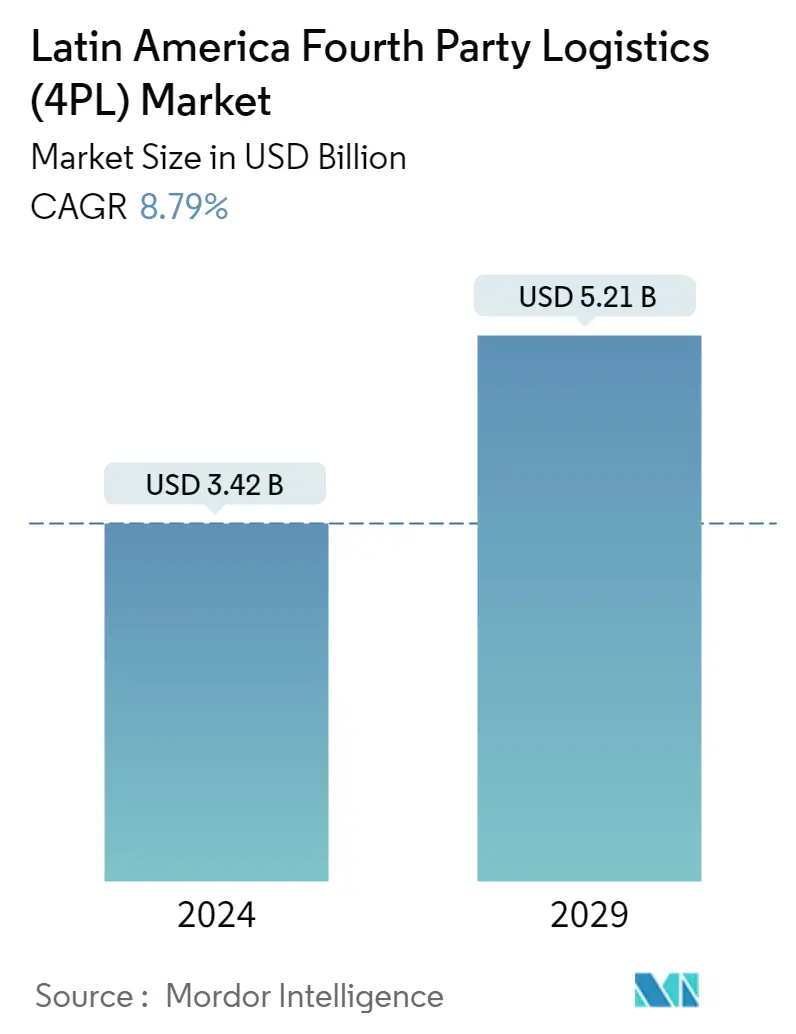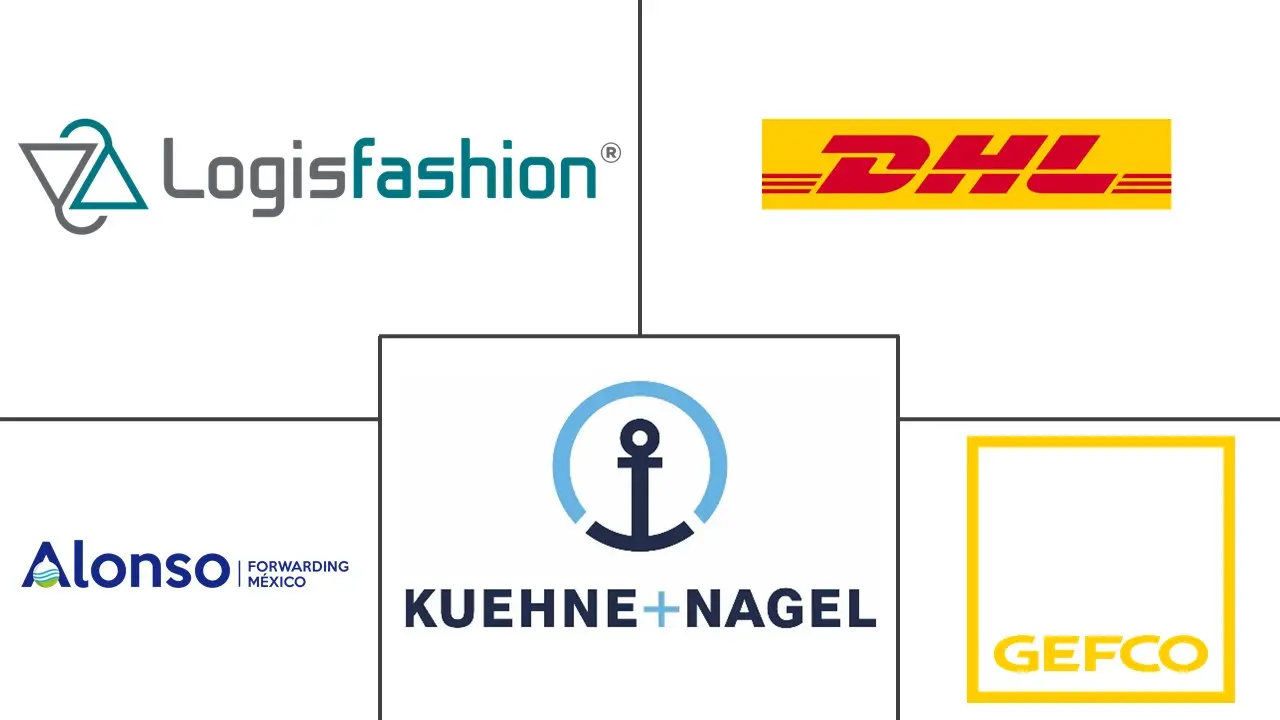Market Size of Latin America Fourth Party Logistics (4PL) Industry

| Study Period | 2019 - 2029 |
| Base Year For Estimation | 2023 |
| Market Size (2024) | USD 3.42 Billion |
| Market Size (2029) | USD 5.21 Billion |
| CAGR (2024 - 2029) | 8.79 % |
| Market Concentration | Low |
Major Players
*Disclaimer: Major Players sorted in no particular order |
Latin America Fourth Party Logistics (4PL) Market Analysis
The Latin America Fourth Party Logistics Market size is estimated at USD 3.42 billion in 2024, and is expected to reach USD 5.21 billion by 2029, growing at a CAGR of 8.79% during the forecast period (2024-2029).
- The market is driven by advanced technology and the services provided by companies to their clients. Furthermore, the market is driven by manufacturing and business expansion in the region.
- Businesses today produce a wide range of goods and conduct business all over the world. Because of all of this, the management of the manufacturing supply chain has become very complicated. So, these outside providers (4PL) come up with creative and complete services to meet their clients' needs. The fourth-party logistics market is growing because more and more companies need a supply chain system that is easy to use and works well, and the process of running a business is getting more complicated. A rise in the need for customized solutions is also expected to drive market growth. But the growth of the market is likely to be slowed by things like companies not wanting to outsource the logistics function and changes in the laws that govern logistics in different countries. Also, an increase in consumer electronics and a growing e-commerce market are expected to help the market grow.
- The logistics industry has grown, and smart and creative IT solutions have changed how the company will move forward.As people's expectations have grown, some companies that make warehouse management software have also started to offer 4PL services.Also, using the web or IT as the main way to coordinate the supply chain lets businesses focus on making things more efficiently and keeping track of their stock.Customized 4PL supply chain solutions include systems for warehouse management, managing income and expenses, automating processes, tracking freight, managing customer relationships, and tracking suppliers.Because of this, businesses may use 4PL logistics solutions to improve the efficiency of their supply chains and put more attention on their products.To reduce unnecessary costs, managing delivery times and order fulfillment becomes simple and achievable.
- Reshoring, which involves moving domestic product production from a foreign country back to the one where the company's products are sold, and nearshoring, which occurs when a company transfers work to a company in its region, could both be the elements that will help get around any potential issue brought on by shortages and backlogs. As we saw in 2022, digitalization was a great way to make the whole supply chain process, from raw materials and transportation to manufacturing and distribution, more clear.Digitalization can help supply chain managers optimize the whole chain from start to finish because it not only improves visibility but also gets rid of manual processes, makes the chain more efficient, and makes it more accurate.Stakeholders in the supply chain have been working to reduce carbon emissions by 2040 and 2050. Reaching this goal has taken a lot of work and planning.
- Now that people want eco-friendly options, the logistics, transportation, and e-commerce industries are slowly changing their strategies to come up with a relevant, responsible logistics solution that puts out less carbon. Ways to do this include making transportation less carbon-intensive, using recyclable materials to cut down on waste, using solar, wind, and other renewable energy sources, building hybrid assembly lines, and making efficient workspaces. It is said that 80% of customers prefer to buy repeat items from companies that recycle their waste. Since the start of the epidemic, supply chains and how to break them have never been the most important thing. Transportation and logistics are important for the flow of goods from where they are made to where they are used, meeting the needs of a wide range of customers.
Latin America Fourth Party Logistics (4PL) Industry Segmentation
Fourth-party logistics (4PL) providers optimize transportation operations, coordinate suppliers, integrate supply chain technologies, synchronize inbound and outbound logistics flows, and model and manage distribution networks. A complete background analysis of the Latin America Fourth Party Logistics (4PL) Market, including the assessment of the economy and contribution of sectors in the economy, a market overview, market size estimation for key segments, emerging trends in the market segments, market dynamics and geographical trends, and COVID-19 impact, is covered in the report.
The Latin America Fourth Party Logistics (4PL) Market is classified based on operational model (Lead Logistics Provider (LLP), Solution Integrator, and Digital Platform Solution Provider (4PL)), end user (FMCG (Includes Products Related to Beauty and Personal Care, Home Care, etc.), retail channel (Hypermarkets, Supermarkets, Convenience Stores, and E-commerce Channels), fashion and lifestyle (Apparel and Footwear), reefer (Fruits, Vegetable, The report offers market size and forecasts in dollars (USD billion) for all the above segments.
| By Operating Model | |
| Lead Logistics Provider (LLP) | |
| Solution Integrator Model | |
| Digital Platform Solutions Provider (4PL) |
| By End-User | |
| FMCG (Fast-moving Consumer Goods - Includes Products Related to Beauty and Personal Care, Home Care, etc.) | |
| Retail (Hypermarkets, Supermarkets, Convenience Stores, E-commerce Channels) | |
| Fashion and Lifestyle (Apparel, Footwear) | |
| Reefer (Fruits, Vegetable, Pharmaceuticals, Meat, Fish, Seafood) | |
| Technology (Consumer Electronics, Home Appliances) | |
| Other End-Users |
| By Country | |
| Mexico | |
| Brazil | |
| Colombia | |
| Chile | |
| Rest of Latin America |
Latin America Fourth Party Logistics (4PL) Market Size Summary
The Latin America Fourth Party Logistics (4PL) market is experiencing significant growth, driven by the increasing complexity of global supply chains and the demand for advanced, technology-driven logistics solutions. As businesses expand their manufacturing and operations across the region, the need for efficient and customizable supply chain management systems has become paramount. This has led to a rise in the adoption of 4PL services, which offer comprehensive solutions to streamline logistics processes. The market is further bolstered by the growth of e-commerce and consumer electronics, as well as the digitalization of infrastructure, which enhances supply chain visibility and efficiency. However, challenges such as reluctance to outsource logistics functions and regulatory changes in different countries may impede market growth.
The Latin American 4PL market is characterized by a fragmented landscape with numerous domestic and international players, including major companies like Deutsche Post DHL and Kuehne + Nagel. These companies are actively innovating and expanding their operations to capitalize on emerging opportunities. The region's burgeoning e-commerce sector, fueled by a rapidly growing online population and increased internet penetration, presents a lucrative market for 4PL services. The integration of advanced IT solutions and data analytics into logistics operations is enabling businesses to optimize their supply chains, reduce costs, and improve customer satisfaction. As the market continues to evolve, strategic partnerships and acquisitions, such as DHL Supply Chain's acquisition of New Transport Applications, are expected to enhance service offerings and expand market reach.
Latin America Fourth Party Logistics (4PL) Market Size - Table of Contents
-
1. MARKET DYNAMICS AND INSIGHTS
-
1.1 Market Overview (Current Scenario of the 4PL market)
-
1.2 Impact of COVID-19 on the Market (Short-term and Long-term Effects on the Market and the Economy)
-
1.3 Market Dynamics (Drivers, Restraints, and Opportunities)
-
1.4 Industry Attractiveness - Porter's Five Forces Analysis
-
1.4.1 Bargaining Power of Suppliers
-
1.4.2 Bargaining Power of Consumers
-
1.4.3 Threat of New Entrants
-
1.4.4 Threat of Substitutes
-
1.4.5 Intensity of Competitive Rivalry
-
-
1.5 Key Companies Across the Value Chain of the Market (IT Companies, Consulting Firms, Logistics Service Providers, etc.)
-
-
2. MARKET SEGMENTATION
-
2.1 By Operating Model
-
2.1.1 Lead Logistics Provider (LLP)
-
2.1.2 Solution Integrator Model
-
2.1.3 Digital Platform Solutions Provider (4PL)
-
-
2.2 By End-User
-
2.2.1 FMCG (Fast-moving Consumer Goods - Includes Products Related to Beauty and Personal Care, Home Care, etc.)
-
2.2.2 Retail (Hypermarkets, Supermarkets, Convenience Stores, E-commerce Channels)
-
2.2.3 Fashion and Lifestyle (Apparel, Footwear)
-
2.2.4 Reefer (Fruits, Vegetable, Pharmaceuticals, Meat, Fish, Seafood)
-
2.2.5 Technology (Consumer Electronics, Home Appliances)
-
2.2.6 Other End-Users
-
-
2.3 By Country
-
2.3.1 Mexico
-
2.3.2 Brazil
-
2.3.3 Colombia
-
2.3.4 Chile
-
2.3.5 Rest of Latin America
-
-
Latin America Fourth Party Logistics (4PL) Market Size FAQs
How big is the Latin America Fourth Party Logistics (4PL) Market?
The Latin America Fourth Party Logistics (4PL) Market size is expected to reach USD 3.42 billion in 2024 and grow at a CAGR of 8.79% to reach USD 5.21 billion by 2029.
What is the current Latin America Fourth Party Logistics (4PL) Market size?
In 2024, the Latin America Fourth Party Logistics (4PL) Market size is expected to reach USD 3.42 billion.

